Thank you! Your comment has been submitted successfully. You should be able to view your question/comment here within a few days.
Error submitting comment. Please try again momentarily.
- All Info
- Reviews (48)
- Q & A (0)
- Videos (2)
- Photos
Redline Trailer Bearings Races Seals Caps - SL150
- Seals
- Grease Seals - Single Lip
- 2.332 Inch O.D.
- 1.500 Inch I.D.
- Redline
| Inner Diameter | Outer Diameter |
|---|---|
| 1.500" | 2.332" |
| Seal Cross Reference | |||||
|---|---|---|---|---|---|
| Dexter | Transcom | National | NOK | Chicago Rawhide/SKF | Timken |
| n/a | 15234VB | 203013 | AF2284E, AF2284E0, AF2285F, AF2285F0 | 14972 | 203013 |
SL150 Grease Seal SL150
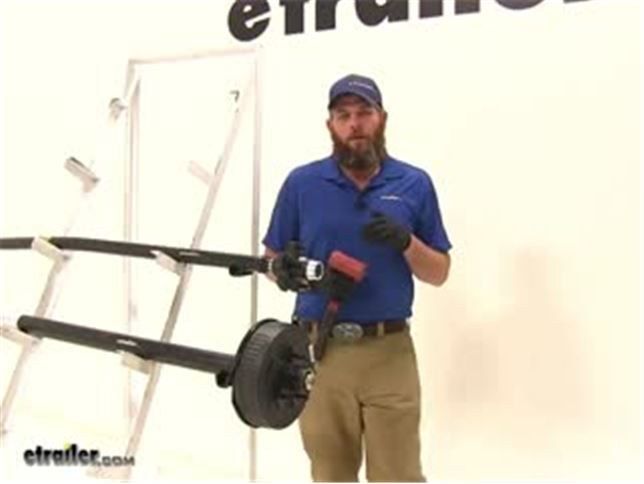

Videos are provided as a guide only. Refer to manufacturer installation instructions and specs for complete information.
Video Transcript for Trailer Bearings Races Seals and Caps Rebuild
Speaker 1: Today we're going to take you through the rebuild process on a couple of hubs. We've got an idler hub, and here we've got a hub and drum assembly. Works with electric rigs, but this can also work for just standard discs, if you've got a disc brake style setup.Basically what we're going to show you is how to get all of the bearings out. How to remove the seal. How to remove the race's if they're damaged, then get them replaced in the proper manner. We'll show you how to use an easy loop hub, which we have here.The first thing we are going to need to do is, get the grease cap off the end.
It can have either a rubber plug in it like this one does, or it can be a solid metal cap.These are pressed fit in there, basically by tapping on them on the back side. To remove them, a deadbolt hammer is typically what we're going to use. We're just going to start tapping as we go around. You'll see a little separation start right here, and slowly it'll work it's way off.Now the next step's going to vary a little bit depending on your axle setup. Do you see this is going to have a keeper that goes around the nut.
And that prevents that from being backed off, or removed. A lot of times you'll have a castle nut, which will have just little tabs that stick off, and there will be a cotter pin that passes through it. Just depending on your application, you need to get the keeper for the nut off. This style we just kind of pry out. A cotter pin you would just remove of course.Once we have that off ...
We'll start to take off the nut here, and the washer that's in behind it. Now yours should look a whole lot more dirty than this. There should be a lot of grease packed in, and through the hub, this one's brand new. We thought it'd be nice to show you the components before the grease was on .. Of our washer that comes off.And then here we're going to have our outer bearing.
Continue to pull that. We're gonig to have our inner bearing here. That sits in the backside of the hub. And we didn't put it in yet, we will show you how to put it in. But a seal would typically be covering the backside here. We'll show you how to use a seal removal tool, or another tool. To get that pried up and out. To get an access to that inner bearing.Now for a drum style like this, that process for disassembly is going to be just the same. One thing to keep in mind if you're using a disc brake setup. You'll have to remove the caliper before the disc is going to come off.Now once we have the spindle exposed, as we said this is going to be really greasy. We want to get all the grease removed, and the first thing we'll do is inspect it. We want to make sure that it looks just like what we have here. Everything's nice and smooth. We don't see any kind of discoloration, or any marring on the metal. Indicating that our bearing's got hot.If you do have any of those symptoms, at this point it's time to replace those bearings. You don't want to repack them. Get new bearings, and put in there. You might have a bearing that's come apart in here. Another surface to ensure is in good condition, is where your seal is going to go. That helps seal all the grease inside of our hub. With a damaged or broken seal, that grease is going to seep out. Either out of the hub, or in this case into our brake assembly.Now if your axle has brakes, we're also going to check the disc. Make sure it doesn't have any issues, or your hub. And this is going to be a hub and drum assembly. The brakes are going to ride on this machine surface. You're going to check that for signs of excessive heat, discoloration, or cracking. And this is our magnet surface. We'll check that surface for the same issues.Now inside the hub regardless if it's a disc brake, it's a drum brake like this. Or just a standard idler style hub. You're going to have an outer race. Would be right here, it's a small tapered piece of metal your bearing sits in, and rotates on. That's basically the outer portion of the bearing.You have the same thing here on the backside. This is called the inner race. Now if those show any signs of wear, overheating, or cracking. Those are also something we'll need to replace, which we'll show you how to do in just a minute.Now, with your brake assembly exposed, if you do have electric brakes like we have here. It's a good idea to check all the components for wear, cracking, maybe missing pieces. Check your pad thickness to make sure those are in good shape. Basically if you have a non working brake assembly and you put everything back together, you're just going to have to take it apart and do it all over again to get back to the brake assembly. This gives you a really good option to be able to change them out.And most applications are going to use a four, or maybe a five bolt flange to hold them in place. And you'll just remove the lock nuts, or sometimes you'll have a hex nut with a lock washer. You want to remove those, and then simply slide your assembly off after you cut the wiring.The friction material itself should also be checked for any kinds of cracking, or overheating. If you have any grease inside the system at all, it's likely it's gotten on those pads. It's a good idea to get those changed. Now as far as the removal of the races go, it's going to be just the same whether we're using an idler style hub like we have here. A drum brake like we have here. You can basically see where the idler is, here in the middle of the hub. It's going to go all the way around there, and we just have this extra material here to provide our braking surface.Now if you're doing a disc brake style job again, it's going to be just the same here with the races living inside of the actual hub portion. You'll just have the discs there for the brakes to make contact. We're going to use this little bit smaller one, it's a little bit easier to manage to show you how to get these out. We've talked about where the races are. The outer here, the inner being closer to the inside, but on the backside of the race there's a little lip. That lip's meant to stick out just a little bit further than the hub, and provide us an area to put our tool on, and help to drive that out.If you look all the way through there on that inner race, you'll see that little lip that sticks out just from the hub slightly, and it gives us enough area to use our tool on. Now generally to remove these you're going to use a punch, similar to this. Some guys will use a screwdriver. Or a piece of pipe. If you have a piece of pipe that's small enough to fit inside of that diameter, you can take that down through and allow it to rest on that lip.Use our punch, and then just need a hammer. And we'll start working that out. We're going to tap all the way around. Kind of equally, and evenly apply the force to get it to come on out of the bottom for us.You can see now as it starts to come out there's going to be a little gap created between the hub and the race. And we can just keep going, bringing it on out. Then you can inspect the inside of the hub surface there. Make sure no damage or anything has occurred, and repeat that same process for the outer race if you plan on removing and replacing that one.Now in the outer flat edge, you can see we're going to have our tapered edge on this side. If we roll our race over to the flat side, typically there's going to be a manufacturers part number on there. That will help you identify which race it is, that you need to go back in your system. If those are rubbed off, worn off, if you can't read them. You can measure the outside, to outside diameter of the race here. It's a good idea to use a micrometer to get it exact.Now here's your basic micrometer. And again, the outside of the race is what we're going to need to measure. You want to go . I set the thickest point there. Looks like this one's going to be about 1.98. That's going to be the measurement you'll want to supply.Now while we've got this out, let's also look at the proper way to measure our bearing. Instead of the outside for the bearing, we need to measure the inside diameter. That's going to be pretty simple. Let's pull that out, find the largest measurement we can. Which here, looks like it's going to be 1.03. With that information, we'll be able to get the correct bearing, and the correct race, so they'll fit together properly and make a full bearing kit for us.Now here's the race, we're going to show you how to get this put back in. Basically just going to press fit inside of our hubs. We need to get it down on there. Kind of like that. And you'll have a couple options. A lot of times you're going to see do it yourself or at homer, just going to use a wooden block. Just place it on there. That's going to get you started, but at that point you'll struggle in getting it to go all the way down into it's seat.Now to take care of that problem, there are several seal drivers that are available. Seal and race drivers that are available out there on the market. It's designed to fit down inside of our race, inside of our hub and get it down there where it needs to go. This is part number ptw83020, has several different sizes, even if you have multiple trailers it's going to do the job.Now the side with the angle on it, is designed to fit down inside of our race. If we use the other side, that's going to be for driving your seal into place. Just want to hold it, and take it on in with your hammer. You'll see, you just want to insure that our race is all the way up against that line on the hub where it's supposed to mate to.Now when it comes time to pack your bearings you're going to have several different ways of doing this. You can just use your hand, is the traditional method. That's going to be the method probably reserved for the very occasional trailer work kind of situation. If you do it once or twice a year, probably get away with it that way.Next you would go to a, kind of a sandwich funnel style almost. If you look inside of there, you can see the bearing. It's located between the two pieces. Just use a grease gun. Start filling that with grease, and that's going to fill our bearing for us. And the third, with this one you're just going to place your bearing down and in. It should be pretty close to center. And then we've got our cone her that's going to go down and secure that.Now I think this style, wastes a little bit more grease than what this style will. This has a dust cap. You can see, you can keep your grease in there, put your dust cap on there and save it for later use. This will be if your going to do it every couple years. And this particular style would be if you're a more regular user.Let's start by showing you how to use a bearing packer. Similar to this. Again, we've just got our grease inaudible 00:11:07 here on the top. And then just slowly start to fill it. Now I like this style quite a bit. I think even regular users might enjoy it, because you can get a really quick visual look at that bearing. You're not going to have to overdo it, or have to much grease.You can kind of see in there now, we're starting to get grease to come out of it. Couple more pumps, we'll be good. You can see we've got grease coming out all the way around. Where all of our bearings are. Got a little bit of excess there. Just take that around the outside of it. And then we should be able to lift it off. And now you can see what we we're talking about. Just a little bit of excess there, that you're just going to wind up wasting.Now we'll take our bearing, we're going to place it right down in our race. And then we'll cap off the back with our seal. Right now our seal's going to fit in just like our race did. It's going to have a little bit of a pressure fit to it. Now very often in this situation, I see people using the four by four method. Kind of here, just placing that on and tapping it. As an option though, if you do have one of these. You can see that's designed to fit right on the top of the seal. And help drive it in.The biggest thing here is, just going to be getting it driven in squarely. You can see, this side's in a little bit further than this side. I'm going to start this side first. Now since we didn't have the opportunity to show you before, we're going to take a look at pulling a seal. Now this is a seal puller, we carry this on our website part number ptw1219. This is meant to hook underneath the seal. And then you kind of pull up on it, and just like our race you'll have to work all the way around that edge. Just bringing it out a little at a time.If you don't have that available. Another option would be a screwdriver. You just kind of get that under the seal, and turn it. And see, that'll allow you to also pop that out. We've taken care of our race. Our inner bearing. Our seal. The last component, before we put our hub back in place is going to be our outer bearing. Now with this bearing, I'll show you the hand packing method.This is definitely . Slightly dirtier method than the bearing packer. When we get grease on our hand we want to look at the larger side of the bearing. This is the smaller side. We have a larger side In between the inside and outside there's a gap. We can see our rollers in there. We want to grab that, and use that gap and shove grease inside of it. Now this is going to take a little bit, you want to work in the same spot until you get the grease pushed all the way through. We can see on the top there we've got a little bit starting to come through.And once we push it in the bottom, and you see it start coming out the of the top in those little drips, it's going to indicate that, that section's fully packed. Just need to work all the way around their outside edge now and do the same thing. Alright, once that's all the way around . The bearing will be ready for use.Now one more thing I like to do. We can see our inner bearing there, and our outer bearing. Well between the two, got a pretty big gap in there. If you'll take a . Pretty good amount of grease. We're just going to go all the way around. See how we can go all the way around the inside and just line that really well. The more grease we have in here, the less chance we have of any moisture getting in there, which can cause corrosion, rust, pitting. Pretty much things we do not like when it comes to bearings, races, and hubs.Put plenty of grease in there. And then this one does have the easy lube spindle, that'll even fill it in more. Now we can get our assembly slid on. I like to keep my thumbs on that outer bearing, just to prevent it from . inaudible 00:15:28 pushed off there. Now we can put on the original hardware that we removed, in taking off our hub the first time. In our case, we had our washer and our nut.Now most commonly you'll see pliers similar to this being used. We basically want to get that tightened down. Once it's fully tightened down you'll feel some resistance in the hub. We back it off just slightly. That'll give us a little bit more freedom of motion there. Something you don't want however . Is any movement in, or out on your hub. You want to be sure that everything is compressed, and you don't have what's called end play. Which would be the play in and out.Once we've got that set, then you'll put on whatever tight keeper yours came with. Get that put back in place. Now with an easy lube style hub, you're going to place your grease gun on the end, and then you can just fill the remainder of that hub up.Now for your typical applications, you're either going to have a solid cap, or a cap that'll have a rubber plug in it. A solid cap's going to be for an axle without the grease inaudible 00:16:51 here on the end. Goes on there. Just knock it on with your rubber mallet. Same with the one with the plug. Just gives you a removable area there, be able to cap that off.We'll show you how to put that on. Now as alternatives as well, a lot of times on boat trailers and marine kind of situations. You'll see a bearing buddy. This is going to apply a little bit of pressure on the grease, you'll fill it up. This kind of comes out just a little bit. That applies constant pressure on the grease to make sure we don't have any air, or anything like that. Then there is also an oil bath hub available. Now this is going to be for use with seals that are going to be designed specifically for oil bath use. You'll have to change that seal.We're using a double lip seal. There are also single lip seals available. Of course a double lip seal is going to give you just a little additional security. Keep that in mind when you order. But let's get this knocked on there now so you can see how that works. We just want to take the cap, we're going to center it. This is going to be very similar to what we did with the seal. And then just gently start tapping it around the outside. And it'll seep down on there for you.It's really going to be the same thing that you'll do with any of the end caps. Now with this side done, it's a good idea to take care of all the other hubs. Get them all on the same maintenance schedule. And as long as you'll periodically check the grease, take your trailer out for a trip occasionally. Just to keep everything lubricated. It should extend the life of these parts, and give us years of good service.
Customer Satisfaction Score:
97% were satisfied with this product
3% of customers were not satisfied
- Product did not meet expectations
- Wrong item was ordered
Customer Reviews
Grease Seal SL150 - SL150
Average Customer Rating: 4.8 out of 5 stars (48 Customer Reviews)

good fit for replacement seal
Like others say great seal, good selection, fast delivery. I was a bit surprised at the E-Trailer packaging. I ordered 12 seals for 3 different SIZE trailers and all 12 were in ONE BAG. So some seals are VERY CLOSE in size to each other, like 2.33 x1.50 vs a 1.68. Needless to say you have to be a McGiver to be doing your own seals anyway, but I had to "Mike" each one and look for numbers on each & seperate for Boat or Dune Buggy Trailers. Thats another thing, Taiwan & China ? And the numbers on these new seals are different than the standard Dexter Transcom National or NOK. Good thing my old seals had those numbers, these dont. Keep good NOTES ! Good Luck next owner if I sell.
Excellent knowledge and follow up. My only stop for trailer parts

Worked well but I first had to fix the mounting surface on the axle where the seal rides. If the surface is corroded as mine was the seal will fail immediately. See pics. Rather than replacing the axle , thin SS sleeves are available that slide over the corroded sealing surface on the axle. Such as PN 382-8005. Get the diameter of the axle sealing surface and match it up with the correct sleeve or buy it with the correct seal as a kit. I used some number 2 form-a-gasket on the shaft before I tapped on the sleeve. Couple years and a bunch of boat launches and it is still holding.
I was searching high and low for a broken replacement hub, bearings, grease seals for an old "built by a farmer 40 years ago" trailer. The sales rep at etrailer helped me identify the proper hub, bearings, grease seals, etc (and this was after speaking to several other dismissive suppliers). All of my future business will go directly to etrailer.com without visiting another site. Prices are fair, delivery was fast and service is unparalleled.

Seems my trailer has odd ball bearings and seals not available or recognized by local parts houses. A quick look on etrailer and my parts were on the way. Cant get any better or easier than that.
I have a late 70's boat trailer that needed new tires and wheel bearings... no kits available so I called etrailer and talked to Kayla. We figured out everything over the phone, Kayla got all the the correct bearings and seals to me fast! The tires I ordered where out of stock, but I was upgraded to the galvanized wheel for free!!!
Thanks Kayla!!!
the seal saved the day on a boat trailer- now we go fish. Having the sizes listed fro all your seals enabled me to select the correct size, which was an unusual size. thanks (correct seal was sl150- got the other as I wasn't sure.)
I originally talked to Katie who was of great help in determining the appropriate bearing sizes. This was an older trailer axel and it took a lot of searching and research . She made careful notes of our findings,and put them in the contact log .
Both of these ladies really know their bearings,and created a package of repair parts... I ordered a set of tires too,and it was delivered to Northern Mi in 1.5 days
Roger Zap PhD
Couldn't find this in town anywhere. Found etrailer on line and got it in a few days. Perfect. Getting replacement bearings next.
Trying to find hub seals for a1975 trailer in itself was a challenge as most vendors do not get into the specs of the product they are selling. Etrailer had everything on there site to the tee when it comes to exact dimensions. Thanks for your attention to detail and seamless ordering process

Perfect fit on my boat trailer. No problems with grease leaking out or water leaking in.
The best deal possible! This seal fit an old farm hub would've costed two times to three times what I paid at Etrailer . The sales person I dealt with was very patient and gave me many choices to pick from as I was measuring and asking questions!
We looked everywhere for this grease seal for our 1970s boat trailer. Found your site, found what we needed and shipping was fast. Thx
completely worng size and did nt match current part number that supposedly matched
Works just fine. Outer surface where the seal is pressed into the hub is bare metal, no paint/sealant. I recommend some sealant especially if it's going on a boat trailer. I used some silicone.
great price and fast delivery. Fit perfect on my V hay rake, old seals were leaking water into bearings
These were perfect fit for my drums/hu bs.
etrailer made it easy to ind what I needed and everything was as expected with the part and delivery

Shaft seals were as advertised and ordered. Online order was simple and on time.

They worked just the way i would expect.
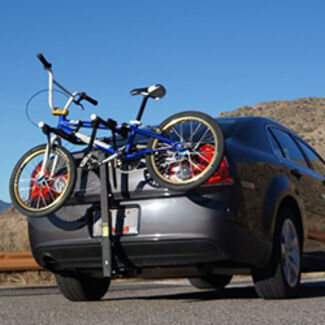
Lawrence

9/29/2021
Still good as new!
Great products! The lady I talked with was very knowledgeable and fixed me up with exactly what I needed!
exactly as advertised. Quick service. Will buy here next time I need something. Price is right.

Great product. Easy to install.
See what our Experts say about this Redline Trailer Bearings Races Seals Caps
- Replacement Bearings Races And Seals For Agricultural TrailerI was unable to find Timken bearings with the LM11949 part number. The part # LM11949 we carry is a replacement outer bearing for AH15450E agricultural hub. These have an inner diameter of .750 inches. The matching outer race for this bearing is part # LM11910. The outer seal that works with this bearing and race is part # SL150. We do not currently offer a kit that includes the # LM11949 bearings. I highly recommend replacing the inner bearings, races, and seals at the same time....
view full answer... - Replacement for Grease Seal SL150The Grease Seal SL150 # SL150 has an inner diameter of 1.500 inches and outer diameter of 2.332 inches. That is the only seal we have with those dimensions, so we do not have another seal that can be substituted. I've linked the page to all our options to assist, but without those specific dimensions you will have a leaking issue that could lead to bearing or spindle damage so I don't recommend using a different size seal.
view full answer... - How to Measure to Determine Replacement Grease Seal for Vintage TrailerI linked our main page for trailer grease seals which has filters that allow you to select parts based on dimensions and other features, such as single-lip or double-lip types. We do not offer any seals with your exact inner and outer dimensions. If you can, re-check those dimensions using a precision digital caliper like # PTW80157. It is best to measure the spindle and the hub bore rather than the original seal part since the seal can become distorted with age and wear. The seal with...
view full answer... - Seal Recommendation for Trailer Hub Assembly DX22XR That Fits Spindle Diameter 1.50 inchThe grease seal part # SL150 has an outer diameter of 2.332 inches which means it will fit in the hub # DX22XR and an inner diameter of 1.50 inches so it will fit your spindle. The hub # DX22XR with this seal should work well for you.
view full answer... - Recommended Replacement Trailer Hub Components I was unable to find the Chicago Rawhide Seal 550081 you said you have on your trailer. With the inner bearing part # LM67048 and Inner Race part # LM67010, and the outer bearing part # LM11949 and Outer Race part # LM11910, the seal we offer is part # SL150 as you mentioned. This seal has an inner diameter of 1.5 inches and an outer diameter of 2.332 inches. To make sure you choose a seal that has the right dimensions for your spindle and hub. You can use a digital caliper like part...
view full answer... - Seal in L44649 Bearing Kit is Too Small to Fit Trailer HubIt sounds like you are talking about the grease seal. Once installed the grease seal should fit flush like your old one. The fact that it is not and that grease is leaking out means that the seal is not the correct size for the hub. What is the diameter of the hub bore where the grease seal fits into the hub? This measurement has to be as accurate as possible so I recommend using calipers such as # PTW80157. If the measurement ends up being at or close to 2.332 inches then you likely need...
view full answer... - Replacement Seal for Trailer Hub with 1.5 ID and 2.328 ODSounds like you're needing the Redline Grease Seal # SL150. This has an ID of 1.5" and an OD of 2.332" like what you're needing. If your bearings are toast, then you'll want to replace those too. If you can get me part numbers or measure the spindle and hub where they ride, I can see what we have, or you can filter through the linked selection. Be sure to use a digital caliper and measure to the 4th decimal (1.234 for example) to ensure proper fitment.
view full answer... - Replacement Grease Seal for Trailer With Bearings LM67048 and LM11949I would recommend you verify the measurements but I am fairly certain with your bearing combo the correct replacement seal would be the # SL150 which has an inner diameter of 1.5 inch and an outer diameter of 2.332. Use a caliper to verify this by measuring outer diameter of current seal and outer diameter of spindle where seal rides.
view full answer... - Replacement Hub Assembly That Uses Inner Bearing LM67048 and Outer Bearing LM11949Currently the only hub we carry that uses the Inner Bearing # LM67048 and Outer Bearing # LM11949 is the Trailer Hub Assembly # AH15450ECOMP. This is a idler hub that is to be used on 3,000lb axles. It has a 4 on 5" bolt pattern and uses threaded bolts rather than lug nuts to hold on the wheel. The bearing races are preinstalled so you will only need the bearings listed above, Grease Seal # SL150 and Grease Cap # TRAG-DC-196.
view full answer... - Difference Between Grease Seals with 1.5000 Inner DiameterWe do have a few different seals that match the 1.500" diameter of your spindle. You will just need to determine which of these seals has an outer diameter that matches with your hub bore. Seal part # 10-9 (also available in a 2 pack as part # RG06-020) has an outer diameter of 1.987" and is the most common. Seal part # SL150 has an outer diameter of 2.332" and is more common on agricultural applications. Attached are some pictures that cross-reference these seals with other known seals...
view full answer... - Replacement Bearings and Seals Based On Printed Number On Face Of BearingFor your bearings, I recommend the etrailer.com Replacement Trailer Hub Bearing # LM67048. For your seals, I can't find the part number or dimensions anywhere, so if you send me dimensions of inside and outside diameters, I'll do what I can to help.
view full answer... - Replacement Bearings For Shorelander Trailer Hub SS733I think that the 1-1/2" measurement that you pulled from your spindle is the landing for the grease seal. Your Inner Bearing # LM67048 (1.250 inner diameter) and Outer Bearing # LM11949 (0.750" inner diameter) do match what the SS733 hub shows as a 1-1/4 x 3/4" hub. We do have the bearings, races and grease seals options that you will need to replace those components of your axle but currently we do not have a hub or hub assembly that will fit your current spindle. Inner Bearing # LM67048 Inner...
view full answer... - Replacement Bearings and Grease Seals for Karavan Ultra 2 Place Snowmobile TrailerKnowing that the trailer uses a # BB1781 Bearing Buddy helps me to identify the correct replacement bearings. We carry two hubs with that bolt pattern, one with a 5 lug on 4-1/2 inch bolt circle, the other much less likely possibility is a 4 lug hub that's typically used for agricultural applications. Your outer bearing is a # LM11949, outer race is # LM11910, and the inner bearing is likely # LM67048, which would be used with the # LM67010 race. You can confirm this by using a digital...
view full answer... - Grease Seals To Fit Trailer with 1.5" Inner and 2.332" Outer Diameter measurements. The Grease Seal # SL150 which has an inner diameter of 1.500, and an outer diameter of 2.332", is going to be the closest we have for that size grease seal. I recommend the Spindle Grease Seal Set # BB60007. This kit is designed to fit a 1-1/4" spindle landing and the outer seal has a 2.33" outer diameter. The kit adds a stainless steel ring that the neoprene grease seal rides on for an extended life span.
view full answer... - Grease Seals for Replacement of Chicago Rawhide # 14974 Grease seals are the # SL150 SealsThe Chicago Rawhide #14974 grease seal has an Outside diameter of 2.332 inches and is a single lip seal. The inside diameter of the seal where it contacts the spindle is 1-1/2 inches and the thickness of the seal or width is 1/2 inches. The correct replacement for this seal is the Grease Seal, item # SL150. The item # RG06-050 seals have an inside diameter of 1.719 inches and an outside diameter of 2.565 inches so they would not be the correct replacement parts.
view full answer... - Availability of Replacement Dust Covers That Fit Over Hub BoreWe do have grease seals that have 1.5" ID but you'll also want to measure where the grease seal makes contact with your hub so that it is a snug fit. If that measures 1.987" then you need part # 10-9 (part # RG06-020 for a 2 pack) and if it measures 2.332" then you'll need part # SL150 instead. It's best to take grease seal and bearing measurements with a digital caliper to ensure that what you get is an exact fit. For the washer that goes on the end of the spindle we do have a variety...
view full answer... - Locating the Correct Grease Seal Size for a Boat TrailerAfter doing some research I was not able to locate a grease seal with a 1.500 inch inner diameter and a 2.500 inch outer diameter. I spoke with my grease seal supplier and they do not carry a grease seal with those dimensions either. If you are measuring the grease seal itself, I would recommend measuring the hub and spindle. Sometimes the rubber of the grease seal and the outer ring can become deformed or damaged. I also recommend using a precise measuring tool such as a dial caliper....
view full answer... - Grease Seal SL150 Fits Bearing LM11949I am showing that you can use the Grease Seal SL150Grease Seal, item # SL150, and the Bearing, item # LM11949, together.
view full answer... - Trailer Bearing Available with Inner Diameter of 1.25 inchesWe may have the bearings you need, but the spindle dimensions you have aren't standard hub dimensions so you may have something that there aren't replacement parts for. For a bearing that has an inner diameter of 1.25 inches and an outer diameter of 2.328 inches you would want the part # LM67048. For a grease seal that matches your dimensions you would want the part # SL150. The components you listed don't match anything we have so we wouldn't' be able to give you a weight capacity.
view full answer... - Replacement for Grease Seal with 2.335 Outside Diameter and 1.5 Inside DiameterThe closest option we have to your measurements is the Grease Seal # SL150 that features an outside diameter of 2.332 inches and an inside diameter of 1.500 inches. This is awfully close to the numbers you provided so you may want to measure your existing seal once more to see if it matches. Also keep in mind that grease seals tend to get a bit distorted from the physical act of removing them from the hub so this is likely the correct seal. If you can find a number stamped inside the seal...
view full answer... - Replacement Trailer Hubs For Spindle That Uses 1-1/4" Inner Bearing and 3/4" Outer BearingThe Agricultural Trailer Hub Assembly # AH15450ECOMP is what you are looking for. It uses a Inner Bearing # LM67048 which has an inner diameter of 1.250" and an Outer Bearing # LM11949 with an inner diameter of .750". You can verify that the Grease Seal # SL150 with the inner diameter of 1.500" matches your spindle. I did notice that there is a lot of scratches on your spindle. If these are deep grooves that your fingernail will catch on you should replace your Spindles # TRU54FR so that...
view full answer... - Trailer Hub Seal Recommendation for Hub with Race LM11910The race number you mentioned isn't a very commonly seen race but it is used on an agricultural hub like the part # AH15450ECOMP which does use the seal you referenced of # SL150.
view full answer... - Can the Agricultural Style 4 on 5 Inch Hubs Be Replaced with a More Common Bolt PatternIt is possible to replace just the trailer hub instead of the whole axle but I would need to know what bearings your current hub has in order to see if that is possible. For example, the only trailer hub we offer with a 4 on 5" bolt pattern is the Trailer Hub Assembly part # AH15450ECOMP and this uses an LM67048 inner and LM11949 outer bearing therefore can be replaced with the Trailer Hub Assembly part # DX22XR because this also uses those same bearings. The Grease Seal SL150 part # SL150...
view full answer... - Grease Seal Recommendation for a Trailer Spindle with 1.5 in Inner DiameterIf your customers are blowing out their grease seals most likely that is due to too much grease being pushed into the hub. Using a Bearing Buddy Seal like the part # BB60005 would give you a grease seal that is more reinforced than a standard one, but a regular seal would also work just fine. The # BB60005 has an inner diameter of 1.375 inches and an outer diameter of 1.980. Since you are looking for a seal that has an inner diameter of 1.5 in you would want the part # 10-9 if the outer...
view full answer...
Do you have a question about this Trailer Bearings Races Seals Cap?
Info for this part was:








At etrailer.com we provide the best information available about the products we sell. We take the quality of our information seriously so that you can get the right part the first time. Let us know if anything is missing or if you have any questions.







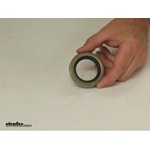




















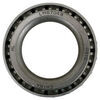























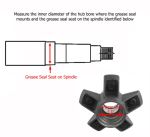



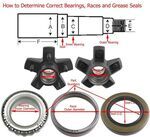
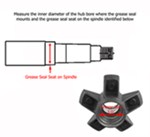
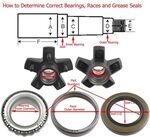
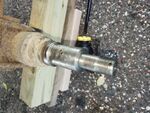
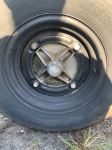
David B.
8/25/2022
Did you measure the items you are trying to replace? What is the part number that you are trying to match it to?